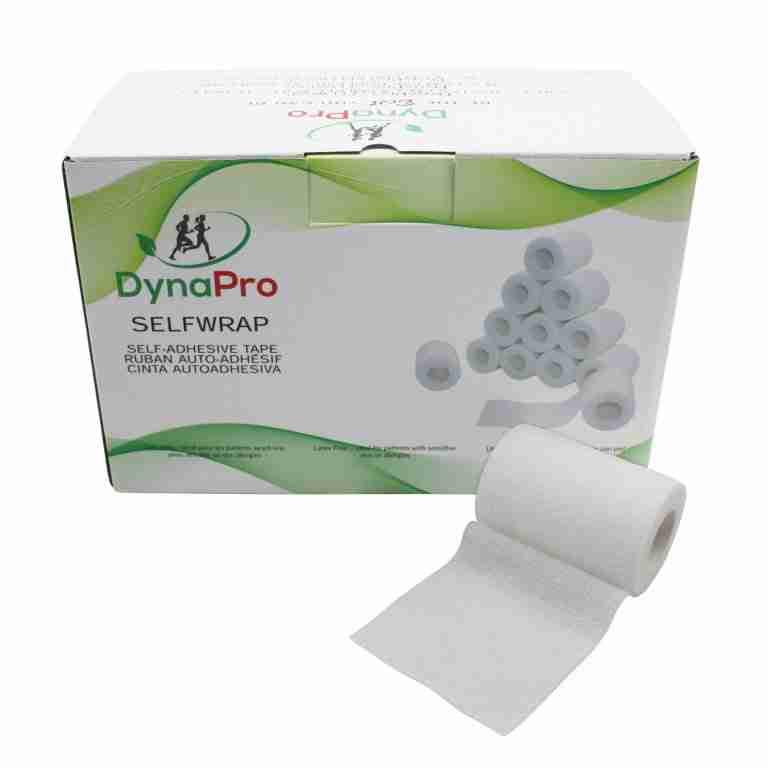3 Valuable Criteria For Choosing An Elastic Bandage For Foot Injuries
Tearable elastic bandages (such as DynaPro Stretchlight) are widely used to treat soft tissue sporting injuries, particularly when these injuries involve joints like the knee, wrist or ankle. In this post, we shall explore a few topics surrounding these bandages. We shall first discuss their unique characteristics and then go on to list the types of foot injuries for which they may be suited. We shall end by listing 3 criteria to follow when choosing an elastic bandage for foot injuries, including injuries to the knee or ankle.
Distinguishing Features of Tearable Elastic Bandages

Tearable elastic bandages possess several unique characteristics that make them suitable for various applications in healthcare. Here are some of these characteristics:
- Stretchability: The construction of elastic bandages includes materials (typically Spandex) that are inherently elastic, allowing them to stretch and conform to the body’s contours. This stretchability provides a snug and secure fit when wrapped around a body part, such as an injured joint or muscle.
- Compression: Elastic bandages exert gentle compression on the wrapped area, which helps reduce swelling, support injured tissues, and promote circulation. The compression effect helps limit excessive movement and provides stability, aiding in the recovery and healing process.
- Breathability: Many elastic bandages are designed with breathable materials that allow air to circulate, preventing excessive moisture buildup and promoting comfort. This breathability helps prevent skin irritation, especially during prolonged wear.
- Versatility: Elastic bandages are versatile and can be used for a variety of purposes. They are commonly employed in sports medicine for joint support, such as ankle or knee stabilization, as well as for managing muscle strains, sprains, or swelling. They can also be utilized in sports, first aid applications, or post-surgical care. Although the bandages are sold in the form of a roll, they can easily be torn to specific sizes or shapes, making them applicable in a wide variety of situations.
- Latex-Free Options: Due to concerns related to latex allergies, many elastic bandages are now manufactured using latex-free materials, including latex free adhesive. This ensures that individuals with latex sensitivities can safely use the bandages without triggering an allergic reaction.
- Variety of Sizes: Elastic bandages are available in various widths and lengths to accommodate different body parts and injury locations. This range of sizes allows for precise and effective wrapping of specific areas, ensuring adequate compression and support. The typical widths of a tearable elastic bandage used for foot injuries is 2″ or 3″. The bandage size used in a particular case may also depend on the age of the patient (e.g. a larger size may be required for an adult than for a child).
In sports medicine, a typical use of a tearable elastic bandage for foot injury treatment would be for support of an unstable ankle.
Types of Foot Injuries Treatable with Tearable Elastic Bandages
We will now explore the types of foot injuries that may be treated using a tearable elastic bandage.
Tearable bandages can be used to treat various foot injuries and provide support and compression. Some common foot injuries that may benefit from elastic bandage application include:
- Ankle Sprains: Tearable elastic bandages are commonly used for ankle sprains to provide compression, stability, and support to the injured ligaments. Wrapping the ankle with an elastic bandage can help reduce swelling, minimize movement, and promote healing.
- Arch Strains or Plantar Fasciitis: Elastic bandages can assist in managing arch strains or plantar fasciitis, conditions that involve inflammation or strain of the arch of the foot. Applying an elastic bandage around the foot and arch can provide gentle compression, support the arch, and alleviate pain during activities.
- Achilles Tendonitis: Elastic bandages can aid in the management of Achilles tendonitis, which involves inflammation of the Achilles tendon at the back of the ankle. Wrapping the ankle and calf with an elastic bandage can provide compression, support, and minimize stress on the Achilles tendon during movement.
- Metatarsalgia: Metatarsalgia refers to pain and inflammation in the ball of the foot, often caused by excessive pressure or overuse. Applying an elastic bandage can provide support, help distribute pressure more evenly across the foot, and reduce discomfort during walking or running.
- Contusions or Bruises: Elastic bandages can be used to manage foot contusions or bruises by providing gentle compression to minimize swelling and promote healing. The bandage can also help protect the injured area from further impact or accidental bumps.
3 Criteria for Choosing a Tearable Elastic Bandage for Foot Injury Treatment
When selecting an elastic bandage for foot injuries, consider the following criteria to ensure an appropriate choice:
- Size and Length: Choose an elastic bandage that is of sufficient size and length to wrap around the foot comfortably. It should be long enough to provide adequate coverage and compression for the specific foot injury.
- Stretchability and Compression Level: Look for an elastic bandage that offers the right balance of stretchability and compression. It should be capable of providing enough compression to support the injured foot without restricting blood circulation or causing discomfort.
- Breathability and Moisture Management: Opt for an elastic bandage that is made from breathable materials to allow air circulation and prevent excessive moisture buildup. This feature helps maintain comfort and reduces the risk of skin irritation or fungal infections.
Conclusion
In this post, we have explored the applications of elastic bandages in the treatment of foot injuries. We have explained the characteristics of these bandages that make them suited for injury treatment, the types of foot injuries that they may be used to treat and the criteria that should be used to choose a tearable elastic bandage for foot injury treatment.
It’s important to note that while elastic bandages can provide temporary support and aid in the management of foot injuries, they should not replace proper medical evaluation and treatment. If you experience a foot injury, it is advisable to consult a healthcare professional, such as a doctor or a sports medicine specialist, for a thorough assessment and appropriate treatment recommendations. They can guide you on the proper use of elastic bandages and provide a comprehensive treatment plan for your specific injury.
We would also emphasize that the specific characteristics of elastic bandages may vary depending on the brand, manufacturer, and intended use. Always follow the instructions provided with the bandage and consult a healthcare professional for guidance on proper usage and application techniques.
Please remember to leave comments and questions in the space provided below.







